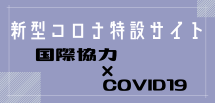IDJ English - IDJ Report
Unresolved AIDS problems in developing countries
Bilateral support for fighting infectious diseases should be strengthened
Acquired Immune Deficiency Syndrome (AIDS) is a public health problem throughout the world, and was widely regarded as an incurable disease in the 1990s and 2000s. Active measures against AIDS have been promoted at the global level since the early 2000s. However, according to the Joint United Nations Programme on HIV/AIDS (UNAIDS), more than 60% of human immunodeficiency virus (HIV)-positive patients in the Middle East and North Africa do not have access to proper treatment. What role should Japan play in addressing this situation?
UNAIDS’ 90-90-90 Goals
It has been many years since AIDS became a worldwide public health issue. The virus that causes AIDS, is transmitted by a variety of routes, including sexual activity, intravenous drug use and the sharing of needles, and intrauterine transmission. The condition has spread worldwide since the first case was reported in the United States in 1981. By 1997, new HIV infections reached 2.9 million per year. The situation in developing countries is particularly serious, and in Southern Africa in the early 2000s, more than 20% of people aged 15 to 49 were infected with HIV.
In response to the global spread of AIDS, the international community, including international organizations, has been making efforts to stem the tide of the disease. Focusing on the past 20 years, Japan announced the Okinawa Infectious Diseases Initiative at the Kyushu–Okinawa G8 Summit in 2000 and pledged funding for AIDS control. At the same time, the establishment of a global funding system was agreed among the participating countries, which led to the establishment of the Global Fund to Fight AIDS, Tuberculosis and Malaria, in 2002. With the establishment of the Global Fund, developing countries that want to tackle the problem of AIDS were able to make use of the ample resources of the Global Fund to implement domestic AIDS countermeasures. In 2003, the World Health Organization (WHO) and UNAIDS proposed the 3 by 5 Initiative, which aimed to provide treatment to 3 million people by 2005.
In 2015, UNAIDS set what it dubbed the “90-90-90” goals in response to the adoption of the Sustainable Development Goals (SDGs) at the UN Summit. The goals are: 1) to diagnose 90% of all HIV-positive people, 2) connect 90% of all people diagnosed with an HIV infection to treatment, and 3) realize viral suppression to below detectable levels in 90% of all people receiving therapy for AIDS. Through these efforts, UNAIDS hopes to end AIDS by 2030, the deadline for the SDGs.
“There is a risk that support will be cut off”
The above-mentioned efforts have been successful over time. Among the world’s 37.9 million HIV-positive people as of 2018, 23.3 million have access to treatment. From a macro perspective, the situation has improved. However, there are still people who find it difficult to obtain medical care, especially in Africa, the Middle East, Eastern Europe, and Central Asia.
Masami Fujita, director of the Global Networking Division of the Bureau of International Health Cooperation of the National Center for Global Health and Medicine (NCGM), has been working on AIDS programs for the WHO, mainly in Asian countries. He said, “in the Asian region, ‘key populations’ such as sex workers, drug users, and men who have sex with men (MSM), transgender people, and their sexual partners are predominantly infected, accounting for 75% of new HIV infections.” A recent trend is that the number of HIV-positive MSM is increasing in the Philippines, especially among the younger generations.
In response to this situation, non-governmental organizations (NGOs) have been implementing AIDS countermeasures such as prevention, testing, and treatment for key populations in Asian countries, supported by funding from the Global Fund and donor countries. However, as economic growth has led to the reduction of support from donors and each country implements its own AIDS countermeasures with its own budget, Fujita said, “the domestic system for funding NGOs is not sufficient in many Asian countries. As a result, there are possibilities of cutting off the support to key populations.”
By contrast, the situation in sub-Saharan Africa remains serious. Since the 2000s, the region, where HIV spread extensively throughout the 1990s, has been actively involved in AIDS treatment, prevention, and social inclusion of HIV-positive people and affected communities for more than a decade. However, the region has not reached the stage where we can say that it has “overcome AIDS.”
Masaki Inaba, Program Director for Global Health of the Africa–Japan Forum (AJF), regularly makes policy recommendations on AIDS in Africa. He has noted that, “although Africa’s access to treatment has improved dramatically, continuous access to treatment remains difficult especially in rural areas, urban poor areas, and conflict-affected areas. There are also problems such as the spread of drug-resistant HIV and combined infections of tuberculosis and AIDS. It is far from the end of AIDS.”
Japan's bilateral support is disappearing
What about support from Japan and its implementing agency, the Japan International Cooperation Agency (JICA), regarding HIV/AIDS countermeasures in the world? In fact, Japan has made great contributions to the Global Fund. As of April 2019, Japan’s contributions totaled roughly $3.5 million, the fifth-largest contribution after the U.S., France, the United Kingdom, and Germany.
However, looking at bilateral support, “Currently, JICA is sending volunteers specializing in infectious disease and AIDS countermeasures via the Japan Overseas Cooperation Volunteers project, but other than that, it has hardly done any AIDS projects.” Shinichi Takenaka, who was in charge of a wide range of AIDS projects in sub-Saharan Africa in the 2000s at JICA, is now a technical advisor to the Stop TB Partnership, which is leading tuberculosis control around the world. He said, “based upon the Okinawa Infectious Diseases Initiative, a number of AIDS projects, including technical cooperation and grant aid, were formed in African countries where JICA has offices. However, as Japan's policy shifts to universal health coverage (UHC) in the latter half of the 2000s, there are no projects specializing in infectious diseases, and in line with that, there are almost no AIDS projects.”
These policy moves are in great contrast to trends in the U.S. and Europe. As a part of bilateral support for developing countries, the U.S. contributes funds through the U.S. President's Emergency Plan for AIDS Relief (PEPFAR). The UK, France, and Germany promote bilateral support to complement the Global Fund by funding projects by local NGOs in developing countries.
Based on the above, what role should Japan play in the future? First of all, as a prerequisite, contributions to the Global Fund and efforts toward the realization of UHC, which Japan has set forth, should be continued. Regarding the latter, if health care services are enhanced in developing countries, many lives will be saved.
In addition to the above, another area that deserves consideration is the strengthening of bilateral support focused on infectious diseases. As for AIDS countermeasures, technical cooperation, such as the establishment of inspection facilities to provide high-quality inspection services and counseling support related to inspections, will continue to be necessary. If such technical cooperation is to be provided, it will be necessary to train Japanese experts who can provide instruction in the field.
If JICA cannot provide its own assistance, it should consider offering direct assistance to local NGOs, much like that provided by Western donors. Or, Japan could help to create a system that allocates HIV countermeasure funding to local NGOs in developing countries.
Of course, AIDS is one of the many infectious diseases that is widespread worldwide, and there are other concerns, such as tuberculosis and malaria, that should also be dealt with. However, this is not a situation in which AIDS issue is inferior to other issues. The people involved in aid programs should re-think what to do to bring about the end of AIDS (Keitaro Fukushima).
International Development Journal 2020 August edition
*****以下、日本語原文*****
燻り続ける開発途上国のエイズ問題
感染症に特化した二国間支援の強化を
1990年代から2000年代にかけて、“不治の病”として世界の社会的課題となった後天性免疫不全症候群(エイズ)。2000年代初頭から世界レベルで積極的なエイズ対策が進められてきたが、国連合同エイズ計画(UNAIDS)によると、中東・北アフリカでは今でもエイズ発症の原因であるヒト免疫不全ウイルス(HIV)陽性者の6割以上が治療にアクセスできていない。こうした現状に日本が果たすべき役割は何か。
UNAIDSの「90-90-90」目標
エイズが世界の社会的課題になってから久しい。性行為やドラッグの回し打ち、または妊婦からお腹の中にいる胎児へ、とさまざまな経路で感染するHIVは、1981年に米国で最初の事例が報告されてから、徐々に全世界に広がり、97年の新規HIV感染者数は290万人にも達した。特に途上国の状況が深刻で、2000年代初頭の南部アフリカでは15歳~49歳の2割以上がHIVに感染していた。
エイズの世界的な蔓延を受けて、国際機関を中心とした国際社会の取り組みが展開された。過去20年に絞ると、2000年の九州・沖縄サミットで日本が「沖縄感染症対策イニシアティブ」を打ち出し、エイズ対策に向けた資金拠出を表明したほか、サミット参加国の間で世界的な資金供給メカニズムの創設で合意がなされ、02年のグローバルファンド(世界エイズ・結核・マラリア対策基金)の設立につながった。グローバルファンドの設立により、エイズ対策に取り組みたい途上国はグローバルファンドの潤沢な資金を活用して、国内のエイズ対策を実施できるようになった。03年には世界保健機関(WHO)とUNAIDSが05年までに300万人に治療を提供することを目指した「3×5」(スリーバイファイブ)を提唱し、エイズ対策は世界的潮流となった。
2015年には国連サミットで持続可能な開発目標(SDGs)が採択されたことを受けて、UNAIDSは「90-90-90」目標を掲げた。これは①HIV陽性者の9割に検査を受けさせ、②その9割を治療につなげ、③さらにその9割が保有するHIVの量を検出可能値以下にまで下げるという目標だ。こうした取り組みによって、SDGsの期限である2030年までにエイズを終息させることを目指している。
「支援が切られる恐れがある」
上記の取り組みが徐々に功を奏し、2018年時点で3,790万人存在したHIV陽性者のうち、2,330万人が治療にアクセスできるようになった。このようにマクロで見ると状況は改善しているが、残念ながら、まだ中東や東欧、中央アジアをはじめ、アジアやアフリカを中心に支援の手が届きにくい人たちがいるのが現状だ。
WHOでアジア諸国を中心にエイズプログラムに取り組んできた(国研)国立国際医療研究センター国際医療協力局の藤田雅美連携推進課長によると、「アジア地域では未だにセックスワーカー、ドラッグユーザー、男性間性交渉者(MSM)、トランスジェンダーとその人たちのセクシュアル・パートナーズなど、『キーポピュレーション』と呼ばれる特定のグループで感染が多く見られ、HIV新規感染者数の7 5 % を占めている」と指摘する。近年の傾向としては、「特にフィリピンにおいて、若い世代を中心にMSMのHIV陽性者が増加している」とのことだ。こうした状況を受け、アジア諸国ではグローバルファンドやドナー国からの支援金を原資に、NGOが中心となって、キーポピュレーションに対する予防、検査、治療といったエイズ対策を実施してきた。しかしながら、経済成長に伴い、ドナーからの支援が減って、各国が自前の予算で国内のエイズ対策を実施するようになる中、藤田氏は「NGOに資金を拠出する国内制度が未だに不十分な国が多く、結果としてキーポピュレーションに対する支援が真っ先に切られる恐れがある」と危機感を募らせる。
他方、サハラ以南のアフリカ地域の状況も依然として深刻だ。90年代を通じて、HIVが広範囲に拡大した同地域では、2000年代以降、エイズ治療、予防、HIV陽性者や影響を受けたコミュニティの社会的包摂などの取り組みが十数年にわたって積極的に取り組まれてきたが、まだ「エイズを克服した」と言える段階にはない。アフリカでのエイズに関する政策提言をしてきた(特活)アフリカ日本協議会(AJF)国際保健部門ディレクターの稲場雅紀氏は、「アフリカの治療アクセスは飛躍的に改善したが、農村部や都市貧困層、紛争地域では特に、継続的な治療アクセスが難しい状況が続いている。また、薬剤耐性を持つHIVの広がりや、結核とエイズの複合感染といった問題もあり、『エイズは終わった』と言うには程遠い状況だ」と語る。
消える日本の二国間支援
翻って、世界で進むエイズ対策において、日本や支援実施機関である国際協力機構(JICA)の支援はどうだろうか。実は日本はグローバルファンドへの拠出で多大な貢献をしている。2019年4月時点で日本の拠出金は米仏英独に続く第5位の計34億5,997万ドルに達している。
しかしながら、二国間支援に目を向けると、「現在、JICAは海外協力隊事業で感染症・エイズ対策隊員を送ってはいるが、それ以外ではエイズ案件をほぼ行っていない」。こう語るのは2000年代にJICAの広域企画調査員として、サブサハラアフリカ地域のエイズ案件を幅広く担当し、現在は世界各地で結核対策を主導するStop TB Partnershipでテクニカル・アドバイザーを務める竹中伸一氏だ。同氏によると、「沖縄感染症対策イニシアティブを受け、JICAが事務所を置くアフリカ諸国で技術協力や無償資金協力を含む数多くのエイズ案件が形成された。だが、2000年代後半に日本の政策がユニバーサル・ヘルス・カバレッジ(UHC)に移っていく中で、感染症に特化した案件がなくなり、それに伴ってエイズ案件もほぼなくなった」と指摘する。二国間支援の一環で「米国大統領エイズ救済緊急計画」(PEPFAR)を通して資金拠出する米国や、途上国のNGOに資金拠出をするなどグローバルファンド案件を補完する二国間支援を独自に展開する英仏独の動きとは対照的である。
以上を踏まえて、今後の支援はどうあるべきであろうか。まず前提条件として、グローバルファンドへの拠出や日本が掲げているUHCの実現に向けた取り組みは続けていくべきだろう。後者については、途上国で保健医療サービスを充実できれば、それだけでも多くの命が救われるからだ。
それでもなお、検討に値すると考えるのが、感染症に特化した二国間支援の強化だ。エイズ対策においては、質の高い検査サービスを提供するための検査施設の整備や検査に関わるカウンセリング支援といった技術協力は引き続き必要となるだろう。こうした技術協力を行うのであれば、現地で指導する日本人専門家の育成も必要になってくるだろう。
日本の援助実施機関であるJICAが独自に支援を展開できないのであれば、欧米ドナーと同様に現地NGOへの直接支援を検討しても良いだろう。もしくは途上国のHIV対策予算を現地NGOに割り当てる制度作りを日本が手助けできるかもしれない。
もちろん、あくまでもエイズは世界的に蔓延する数ある感染症の一つで、他にも結核やマラリアなど対処すべき感染症は存在する。しかし、「他の課題があるから劣後する」という類いの話ではない。エイズを終わらせるために何をすべきか、援助関係者には改めて考えてもらいたい。(本誌編集部:福島 勁太郎)
『国際開発ジャーナル』2020年8月号掲載記事



